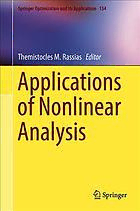Table Of ContentSpringer Optimization and Its Applications
Volume134
ManagingEditor
PanosM.Pardalos(UniversityofFlorida)
Editor–CombinatorialOptimization
Ding-ZhuDu(UniversityofTexasatDallas)
AdvisoryBoards
J.Birge(UniversityofChicago)
C.A.Floudas(TexasA&MUniversity)
F.Giannessi(UniversityofPisa)
H.D.Sherali(VirginiaPolytechnicandStateUniversity)
T.Terlaky(LehighUniversity)
Y.Ye(StanfordUniversity)
AimsandScope
Optimizationhasbeenexpandinginalldirectionsatanastonishingrateduringthe
lastfewdecades.Newalgorithmicandtheoreticaltechniqueshavebeendeveloped,
thediffusionintootherdisciplineshasproceededatarapidpace,andourknowledge
ofallaspectsofthefieldhasgrownevenmoreprofound.Atthesametime,oneofthe
most striking trends in optimization is the constantly increasing emphasis on the
interdisciplinarynatureofthefield.Optimizationhasbeenabasictoolinallareasof
appliedmathematics,engineering,medicine,economicsandothersciences.
The series Springer Optimization and Its Applications aims to publish state-
of-the-art expository works (monographs, contributed volumes, textbooks) that
focusonalgorithmsforsolvingoptimizationproblemsandalsostudyapplications
involvingsuchproblems.Someofthetopicscoveredincludenonlinearoptimization
(convex and nonconvex), network flow problems, stochastic optimization, optimal
control, discrete optimization, multi-objective programming, description of soft-
warepackages,approximationtechniquesandheuristicapproaches.
Moreinformationaboutthisseriesathttp://www.springer.com/series/7393
Themistocles M. Rassias
Editor
Applications of Nonlinear
Analysis
123
Editor
ThemistoclesM.Rassias
DepartmentofMathematics
NationalTechnicalUniversityofAthens
Athens,Greece
ISSN1931-6828 ISSN1931-6836 (electronic)
SpringerOptimizationandItsApplications
ISBN978-3-319-89814-8 ISBN978-3-319-89815-5 (eBook)
https://doi.org/10.1007/978-3-319-89815-5
LibraryofCongressControlNumber:2018946611
MathematicsSubjectClassification:26-XX,28-XX,30-XX,32-XX,34-XX,35-XX,37-XX,39-XX,
41-XX,43-XX,45-XX,46-XX,47-XX,49-XX,52-XX,53-XX,54-XX,57-XX,58-XX,65-XX
©SpringerInternationalPublishingAG,partofSpringerNature2018
Thisworkissubjecttocopyright.AllrightsarereservedbythePublisher,whetherthewholeorpartof
thematerialisconcerned,specificallytherightsoftranslation,reprinting,reuseofillustrations,recitation,
broadcasting,reproductiononmicrofilmsorinanyotherphysicalway,andtransmissionorinformation
storageandretrieval,electronicadaptation,computersoftware,orbysimilarordissimilarmethodology
nowknownorhereafterdeveloped.
Theuseofgeneraldescriptivenames,registerednames,trademarks,servicemarks,etc.inthispublication
doesnotimply,evenintheabsenceofaspecificstatement,thatsuchnamesareexemptfromtherelevant
protectivelawsandregulationsandthereforefreeforgeneraluse.
Thepublisher,theauthorsandtheeditorsaresafetoassumethattheadviceandinformationinthisbook
arebelievedtobetrueandaccurateatthedateofpublication.Neitherthepublishernortheauthorsor
theeditorsgiveawarranty,expressorimplied,withrespecttothematerialcontainedhereinorforany
errorsoromissionsthatmayhavebeenmade.Thepublisherremainsneutralwithregardtojurisdictional
claimsinpublishedmapsandinstitutionalaffiliations.
Printedonacid-freepaper
ThisSpringerimprintispublishedbytheregisteredcompanySpringerInternationalPublishingAGpart
ofSpringerNature.
Theregisteredcompanyaddressis:Gewerbestrasse11,6330Cham,Switzerland
Preface
TheApplicationsofNonlinearAnalysispresentssomeclassicalandnewresultsin
importantsubjectsofnonlinearanalysisanditsapplications.
The contributing papers have been written by experts from the international
mathematical community. These papers deepen our understanding of some of the
mostessentialresearchproblemsandtheoriesofnonlinearnature.
Efforthasbeenmadeforthepresentationoftheconcepts,theories,andmethods
toreachwidereadership.
I would like to express my thanks to all the scientists who contributed to the
preparationofthisvolume.Iwouldalsoliketoacknowledgethesuperbassistance
ofthestaffofSpringerforthepublicationofthisbook.
Athens,Greece ThemistoclesM.Rassias
v
Contents
NewApplicationsofγ-Quasiconvexity ........................................ 1
ShoshanaAbramovich
1 Introduction .................................................................. 1
2 JensenandSlater-Pecˇaric´ TypeInequalitiesforN-quasiconvex
Functions..................................................................... 3
2.1 Jensen and Slater-Pecˇaric´ Type Inequalities for
N-quasiconvexFunctionswithNon-negativeCoefficients......... 3
2.2 JensenandSlater-Pecˇaric´ TypeInequalitiesforSteffensen’s
Coefficients........................................................... 5
3 HardyTypeInequalitiesforγ-QuasiconvexFunctions.................... 9
4 γ-QuasiconvexityandNewHölderTypeInequalities ..................... 10
5 MinkowskiTypeInequalitiesUsing1-Quasiconvexity.................... 13
6 Boundsof“Jensen’sGap”forN-quasiconvexFunctions.................. 15
6.1 BoundsforDifferenceBetweenTwo“Jensen’sGaps”for
N-quasiconvexFunctions............................................ 15
6.2 JensenGapandTaylorPowerSeries................................ 18
References ......................................................................... 19
CriteriaforConvergenceofIteratesinaCompression-Expansion
FixedPointTheoremofFunctionalType ..................................... 21
RichardI.Avery,DouglasR.Anderson,andJohnnyHenderson
1 Introduction .................................................................. 21
2 Preliminaries ................................................................. 22
3 Application................................................................... 27
References ......................................................................... 35
OnLagrangianDualityinInfiniteDimensionandItsApplications ....... 37
AntonioCausa,GiandomenicoMastroeni,andFabioRaciti
1 Introduction .................................................................. 37
2 LagrangianDualityinaClassicalFramework.............................. 38
3 ACharacterizationofStrongDualityinInfiniteDimension............... 46
vii
viii Contents
4 ApplicationtoGeneralizedNashEquilibriumProblemsinInfinite
DimensionalSpaces ......................................................... 51
4.1 TheSettingoftheGame............................................. 51
4.2 LagrangeMultipliersRule........................................... 53
4.3 TheRoleofAssumptionS........................................... 55
5 ConclusionandFurtherResearchDirections............................... 58
Appendix........................................................................... 58
References ......................................................................... 59
Stability Analysis of the Inverse Problem of Parameter
IdentificationinMixedVariationalProblems................................. 61
M.Cho,A.A.Khan,T.Malysheva,M.Sama,andL.White
1 Introduction .................................................................. 61
2 ProblemFormulationandPreliminaryResults............................. 63
3 OptimizationFormulations.................................................. 68
4 AsymptoticStabilityoftheMOLSApproach.............................. 72
5 LocalStabilityEstimates.................................................... 76
5.1 StabilityoftheOutputLeast-SquaresApproach.................... 77
5.2 StabilityoftheModifiedOutputLeast-SquaresApproach......... 84
5.3 StabilityoftheEnergyOutputLeast-SquaresApproach........... 87
6 ComputationalResults....................................................... 90
6.1 ElasticityImagingInverseProblem ................................. 91
6.2 IdentificationinStokesEquations................................... 92
6.3 PerformanceAnalysis................................................ 94
6.4 ErrorAnalysisforDecreasingλ..................................... 94
7 ConcludingRemarks......................................................... 96
Appendix:ToolsfromStabilityandOptimizationTheory ...................... 97
References ......................................................................... 99
NonlinearDualityinBanachSpacesandApplicationstoFinance
andElasticity ..................................................................... 101
G.Colajanni,PatriziaDaniele,SofiaGiuffrè,andAntoninoMaugeri
1 TheStrongDualityintheInfinite-DimensionalSetting ................... 101
1.1 AssumptionS......................................................... 102
(cid:2)
1.2 AssumptionS ........................................................ 104
1.3 StrongDualityintheCaseofNonlinearEqualityConstrains...... 104
1.4 NES(NonEmptySubdifferentialCondition)....................... 108
2 ApplicationstotheGeneralFinancialEquilibriumProblem .............. 109
2.1 PresentationoftheModel............................................ 109
2.2 TheDualityfortheFinancialEquilibriumProblem................ 115
2.3 TheViewpointsoftheSectorandoftheSystem ................... 117
2.4 TheContagionProblem.............................................. 119
2.5 AnExampleofaMarkowitz-TypeRiskMeasure .................. 121
3 ApplicationstotheElastic-PlasticTorsionProblem ....................... 121
3.1 PresentationoftheProblem.......................................... 121
3.2 TheElastic-PlasticTorsionProblemforLinearOperators......... 123
Contents ix
3.3 The Elastic-Plastic Torsion Problem for Nonlinear
MonotoneOperators ................................................. 128
3.4 VonMisesFunctions................................................. 133
3.5 RadialSolutions...................................................... 134
References ......................................................................... 137
SelectivePrioritiesinProcessingofBigData................................. 141
NicholasJ.Daras
1 Introduction .................................................................. 141
2 RationalChoiceofDataSets ............................................... 142
2.1 ProgramsofDataSelections......................................... 142
2.2 DataSelectionPreferences........................................... 143
2.3 WeightedDataSystemsandDataAmountProcessing
Capacities............................................................. 146
2.4 Topology of the Space of Data Selection Preferences:
NeighboringSelectionPreferences.................................. 147
2.5 TheLowerHemicontinuityfortheRationalChoiceofData
Amount ............................................................... 149
2.6 MeanRationalDataAmountChoice................................ 151
3 ContrastingSelectivePriorities ............................................. 162
3.1 Introduction........................................................... 162
3.2 MainDefinitions ..................................................... 163
3.3 ContrastCoreandContrastEquilibriums .......................... 165
3.4 DeterminatenessofDataEquilibriumVectors...................... 170
References ......................................................................... 173
GeneralInertialMannAlgorithmsandTheirConvergenceAnalysis
forNonexpansiveMappings .................................................... 175
Qiao-LiDong,YeolJeCho,and ThemistoclesM.Rassias
1 Introduction .................................................................. 175
2 Preliminaries ................................................................. 178
3 TheGeneralInertialMannAlgorithms..................................... 179
3.1 RevisittheAcceleratedMannAlgorithm ........................... 179
3.2 Algorithms............................................................ 181
4 ConvergenceAnalysis....................................................... 182
5 Applications.................................................................. 186
6 NumericalExamplesandConclusions...................................... 188
References ......................................................................... 189
ReversesofJensen’sIntegralInequalityandApplications:ASurvey
ofRecentResults................................................................. 193
SilvestruSeverDragomir
1 Introduction .................................................................. 193
2 ARefinementandaDivided-DifferenceReverse.......................... 199
2.1 GeneralResults....................................................... 199
2.2 ApplicationsfortheHölderInequality.............................. 206
2.3 Applicationsforf-Divergence...................................... 208
x Contents
3 ReverseInequalitiesinTermsofFirstDerivative .......................... 213
3.1 GeneralResults....................................................... 213
3.2 ApplicationsfortheHölderInequality.............................. 220
3.3 Applicationsforf-Divergence...................................... 223
4 MoreReverseInequalities................................................... 225
4.1 GeneralResults....................................................... 225
4.2 ApplicationsfortheHölderInequality.............................. 232
4.3 Applicationsforf-Divergence...................................... 237
5 SuperadditivityandMonotonicityProperties............................... 239
5.1 GeneralResults....................................................... 239
5.2 ApplicationsfortheHölderInequality.............................. 245
5.3 Applicationsforf-DivergenceMeasures........................... 246
6 InequalitiesforSelfadjointOperators....................................... 247
6.1 PreliminaryFacts..................................................... 247
6.2 ReversesforFunctionsofOperators ................................ 249
6.3 SomeExamples ...................................................... 256
References ......................................................................... 261
OrderingStructuresandTheirApplications ................................. 265
GabrieleEichfelderandMariaPilecka
1 Introduction .................................................................. 265
2 Pre-andPartialOrders....................................................... 266
3 OrderingStructuresinLinearSpaces....................................... 268
3.1 Pre-orders,PartialOrdersandCones................................ 268
3.2 Bishop-PhelpsCones................................................. 272
3.3 PolyhedralCones..................................................... 278
3.4 OrderingSets......................................................... 280
4 VariableOrderingStructures................................................ 283
4.1 IntroductiontoVariableOrderingStructures ....................... 283
4.2 BasicPropertiesofVariableOrderingStructures................... 288
4.3 OrderingMapswithBPCones ...................................... 293
5 SetRelations ................................................................. 298
References ......................................................................... 301
AnOverviewonSingularNonlinearEllipticBoundaryValueProblems.. 305
FrancescaFaraciandGeorgeSmyrlis
1 Introduction .................................................................. 305
2 Preliminaries ................................................................. 313
3 ThreeSolutions .............................................................. 314
4 MultipleSolutions ........................................................... 326
References ......................................................................... 333
ThePilgerschritt(Liedl)TransformonManifolds........................... 335
WolfgangFörg-Rob
1 Introduction:TheMainIdea................................................. 335
2 ThePilgerschrittTransformonGroups..................................... 336
Contents xi
3 ThePilgerschrittTransformonManifolds.................................. 337
4 Summary ..................................................................... 353
References ......................................................................... 353
OnSomeMathematicalModelsArisinginLubricationTheory............ 355
D.GoelevenandR.Oujja
1 Introduction .................................................................. 355
2 ReynoldsFreeBoundaryProblem .......................................... 357
2.1 IterativeAlgorithm................................................... 359
2.2 AnAdaptiveFiniteElementMethod................................ 361
2.3 NumericalResults.................................................... 364
3 Elrod-AdamsFreeBoundaryProblem...................................... 368
3.1 AOne-DimensionalProblem........................................ 369
3.2 ApproximationoftheElrod-AdamsProblem ...................... 371
3.3 Elasto-HydrodynamicProblem...................................... 374
4 TheEvolutionFreeBoundaryProblem..................................... 377
4.1 Existence,UniquenessandContinuityoftheSolution............. 379
4.2 ASemi-DiscretisedEulerScheme .................................. 381
References ......................................................................... 383
OntheSpectrumofaNonlinearTwoParameterMatrixEigenvalue
Problem ........................................................................... 387
MichaelGil’
1 IntroductionandStatementoftheMainResult ............................ 387
2 ProofofTheorem1.......................................................... 390
3 MatriceswithJointSchurBasis............................................. 392
4 BoundsViaDeterminants ................................................... 394
5 PerturbationofProblem(1.1),(1.2)......................................... 395
6 GerschgorinTypeBoundsforSpectra...................................... 397
7 SharpnessofTheorem1..................................................... 400
8 Conclusion ................................................................... 401
References ......................................................................... 402
OnthePropertiesofaNonlocalNonlinearSchrödingerModeland
ItsSolitonSolutions.............................................................. 403
TheodorosP.HorikisandDimitriosJ.Frantzeskakis
1 Introduction .................................................................. 403
2 The1DScalarNonlocalSystem ............................................ 406
2.1 ModulationInstabilityandBrightSolitons ......................... 406
2.2 DarkandAnti-DarkSolitons ........................................ 409
3 The1DVectorNonlocalSystem............................................ 413
3.1 VanishingBoundaryConditions..................................... 418
3.2 Non-vanishingBoundaryConditions ............................... 419
3.3 VanishingandNon-vanishingBoundaryConditions............... 423
4 TheFully3DScalarNonlocalSystem...................................... 426
4.1 TheBoussinesqEquation............................................ 429
4.2 Kadomtsev-Petviashvilli-TypeEquations........................... 431

